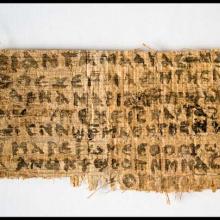papyrus
The Vatican's newspaper has declared the controversial “Jesus wife” papyrus fragment “a fake."
L'Osservatore Romano on Friday (Sept. 28) devoted two articles to Harvard professor Karen King's claim that a 4th century Coptic papyrus fragment showed that some early Christians believed that Jesus was married.
The announcement of the discovery on Sept. 18 made headlines worldwide but was met with skepticism by scholars who questioned the authenticity of the fragment.
In the Vatican daily, a detailed and critical analysis of King's research by leading Coptic scholar Alberto Camplani is accompanied by a punchy column by the newspaper’s editor, Giovanni Maria Vian, who is a historian of early Christianity.
Vian writes that there are “considerable reasons” to think that the fragment is nothing more than a “clumsy fake.” Moreover, according to Vian, King's interpretation of its content is “wholly implausible” and bends the facts to suit “a contemporary ideology which has nothing to do with ancient Christian history, or with the figure of Jesus”.
“At any rate, it's a fake,” he concludes.
In a surprise announcement that seemed scripted by the novelist Dan Brown, a Harvard professor revealed an ancient scrap of papyrus on Tuesday (Sept. 18) that purports to refer to Jesus' wife.
The so-called "Gospel of Jesus' Wife" presents a dialogue between Jesus and his disciples, said Karen King, a well-respected historian of early Christianity at Harvard Divinity School.
The fourth-century fragment says, "Jesus said to them, 'My wife ...,'" according to King. The rest of the sentence is cut off. The fragment also says "she will be able to be my disciple," according to King.
The discovery that some ancient Christians thought Jesus had a wife could shake up centuries-old Christian traditions, King suggested.
But even King acknowledged that questions remain about the receipt-sized scrap, which contains just 33 words and incomplete sentences. Here are five of the biggest questions.

